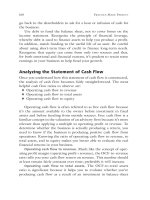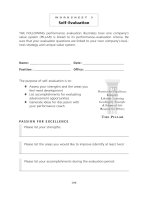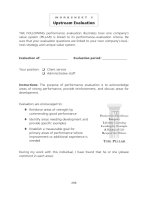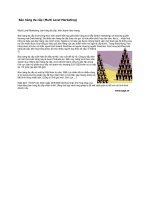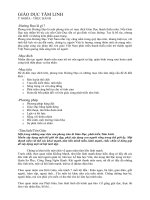Tài liệu Practice Made Perfect 12 pptx
Bạn đang xem bản rút gọn của tài liệu. Xem và tải ngay bản đầy đủ của tài liệu tại đây (127.59 KB, 10 trang )
88 PRACTICE MADE PERFECT
ing, or unsuited to their work style. By knowing their orientation,
you can place them in the right position within your firm—whether
it’s a client-service, analytical, compliance, management, or sales
position or some other role that you deem critical.
S
TAFF DEVELOPMENT BEGINS with the definition of performance
expectations for the specific position, as discussed in chapter 5.
The discussion then must go beyond the specific measurables for the
job and articulate the behaviors and values employees must demon-
strate. That’s done by defining what’s important to the organiza-
tion. At Moss Adams, for example, we’ve adopted a concept called
PILLAR, which guides all of our hiring, staff development, coach-
ing, and advancement. PILLAR stands for
P —passion for excellence
I —integrity
L —lifetime learning
L —lead by example
A —a balanced life
R —respect for others
The concept encourages both professional and personal develop-
ment, and we find these characteristics form the building blocks
for a dynamic organization. To create a culture that embraces this
concept, each element must be incorporated into the performance-
review process and into how we go about selecting new partners or
shareholders for the firm. Your firm’s values statement should be sim-
ilarly integrated into your approach to developing human capital.
In a service business, all members of the professional staff must
focus on both bringing in new clients and serving them well. But as
you can see from the PILLAR framework, you can apply a standard
89
THE
CARE AND
PREENING
OF STAFF
Professional Development
6.
90 PRACTICE MADE PERFECT
of evaluation that goes beyond revenue production. To help evaluate
how well individuals adopt PILLAR as a tenet of their professional
life within our firm, we use an appraisal process.
The Appraisal Process
Employees need and want feedback. Whether he’s the boss or the
lowest-ranking employee, a person wants and needs to know how
others think he’s doing.
What to Evaluate
By employing the discipline of a formal appraisal process, you can
evaluate an individual’s specific performance goals for the appraisal
period. You can also explore issues important to your culture and
use what you learn as a foundation for coaching people to achieve
higher levels of performance. The numbers can be measured on
their own. The challenge for you is to evaluate all of the other ele-
ments that combine to make your culture what it is—or what you
want it to be.
For example, to evaluate passion for excellence, you might rate
your staff in terms of the extent to which they
! demonstrate pride in their work
! complete their work on time and on budget
! solve problems effectively
! meet client-service expectations
! communicate clearly and listen well
To measure integrity, you might rate the staff on whether they
! behave unethically or tolerate unethical behavior of others
! maintain their continuing-education requirements willingly
! put the firm at risk with their own behavior
To assess lifetime learning, you might explore whether they
! are committed to expanding their knowledge and education
! apply technology tools well
THE CARE AND PREENING OF STAFF: PROFESSIONAL DEVELOPMENT 91
To find out whether they lead by example, you might ask
whether they
! demonstrate a positive attitude toward the firm’s goals
! take responsibility for actions and accept responsibility for
mistakes
! act as a role model or mentor for others
To measure a balanced life, you’ll want to observe how well they
! act as a role model in how they balance business and personal
activities
! avoid becoming obsessive about work
! avoid becoming obsessive about play. (Remember, a balanced
life doesn’t mean taking a lot of days off from work but rather
keeping work and nonwork in sync.)
To assess their respect for others, you may want to rate them on
whether they
! respond to feedback from others respectfully
! keep you informed of progress on client work, if appropriate
! treat colleagues and subordinates respectfully
! respect clients in what they say and do and how they respond to
issues
Your challenge is to make sure that every person in the organiza-
tion adopts not just one of the virtues but rather the total concept.
Partners, for example, will say that PILLAR is not appropriate for
them because nobody would expect them to lead “a balanced life.”
After all, they’re the most important person on the planet and God
only knows what would happen if they didn’t spend all their time
in the office. But it’s particularly critical that partners, of all people,
exhibit the values and behavior that have been defined as important
to the organization.
We must continually remind our partners at Moss Adams that
their succession (and, consequently, retirement plan) depends on the
admittance of future partners. And if people think that partnership
is a dog’s life, they won’t aspire to it. This doesn’t apply only to the
balanced-life concept but to the other virtues as well, like passion for
92 PRACTICE MADE PERFECT
excellence and lifelong learning. We expect all of our people—but
especially our partners—to lead by example. Behavioral change,
unfortunately, comes slowly—unless it comes by virtue of a near-
death experience.
We try to weed out those in the firm who cannot embrace these
concepts. No matter how big their economic contribution to the
firm, people who set negative examples eventually sap the firm of its
lifeblood. The long-term economic toll of bad apples is significant.
PILLAR, of course, is just an example of how one firm reinforces
its expectations and the culture it’s trying to create. Each firm must
establish its own boundaries and expectations, although your firm is
free to borrow the PILLAR approach if you feel it applies. The key
is to be clear about what you expect of everyone, know what culture
you want to build and sustain, and have a means for evaluating and
reinforcing the right behavior. Should you choose to ignore all of
the soft issues and focus solely on making money, that is a clear
statement of culture and will appeal to some people. But we would
recommend broadening your perspective.
How to Evaluate
Most firms that are successful in reinforcing behavior do so through
a structured evaluation process in which peers evaluate peers, super-
visors evaluate subordinates, and subordinates evaluate supervisors
(upstream evaluation).
A peer evaluation allows your colleagues to judge you and your
performance against your performance objectives and the culture
that you’re trying to create. By pointing out when you’re drifting
away from the mark or calling attention to your strengths or weak-
nesses, they give you the opportunity and the insight to improve.
An upstream evaluation allows your subordinates to evaluate you
objectively, knowing there will be no negative consequences from
showing you how those who work for you perceive you. This is criti-
cal for building a dynamic organization because if you’re not trusted,
respected, or liked, you will lose your ability to leverage your busi-
ness effectively.
Of course, the smaller the firm, the harder it is to employ these
tools effectively because everyone knows the source of the com-
THE CARE AND PREENING OF STAFF: PROFESSIONAL DEVELOPMENT 93
ments. That’s why you must encourage openness and candor when
eliciting these appraisals and make it clear that you will not seek retri-
bution for criticism. As you listen to the constructive comments and
you work to change either the perception or the reality, you begin to
create a team atmosphere of trust and respect that contributes to the
success of the business.
Larger practices can create a more structured appraisal process
and, to some degree, preserve anonymity for subordinates who
are doing upstream evaluations of the practice leaders. Some firms
outsource this process to consultants to ensure objectivity and trust
in the process. If the owner has a business coach, for example, the
coach would be an appropriate choice for compiling the responses,
and the coach would gain a better foundation for coaching the indi-
vidual in business matters.
In the late 1990s, we were asked by a prominent financial adviser
to serve in this intermediary role. He seemed to be a living example
of someone “lonely at the top.” It wounded him when he heard
criticism of himself from people in the firm or even from others in
the industry. Yet he was not sure how to minimize this or even what
issues to address. To help, we created an upstream evaluation process
that applied not only to him but also to anyone in the firm who had
employees reporting to them. Over a three-year period, we tracked
and monitored each manager’s evaluations, but especially his, since
he was most eager for the feedback.
In the first year, the semiannual evaluations were very tentative;
the staff would give him very high scores (on a scale of one to five),
but their comments tended to be more critical and out of sync with
the numeric evaluation they assigned. We used the comments as the
basis for counseling him. In the second year, when the staff saw that
the owner did not blast them for what they said, they tended to score
more accurately and their comments were more substantive. By the
third year, we saw a perceptible increase in trust.
Although we were pleased to see the evaluation process take root,
we were even more pleased to see how constructive feedback on issues
of importance to the firm helped the owner and his senior-level peo-
ple improve their performance and their relationship with their team
and reduce turnover. With each evaluation, we were able to counsel
94 PRACTICE MADE PERFECT
the owner on how well he communicated with the staff, how well
he recognized their contributions to the firm, how he awarded pro-
motions, and how effectively he encouraged employees to improve
their own performance. Over time, the business became both more
efficient and more profitable. But oddly enough, this improvement
did not result from a greater emphasis on sales; it occurred because
there was greater emphasis on the firm’s mission and culture and a
unified commitment to the firm’s goals.
Coaching and Development
We find that the biggest mistake advisers make is hiring people
who do not match the job. The second biggest mistake is failing to
coach and develop people once they have them in the fold. One of
the most glaring gaps in the human-capital capabilities of advisers is
their lack of ability or interest in training, coaching, developing, and
mentoring others in their organization.
Once you have defined the expectations of the job—both specific
performance criteria and cultural values—and evaluated employees
against those criteria via the appraisal process, you need to take what
you learned and coach employees to higher levels of performance. In
some cases, you need to evaluate whether they are, in fact, coachable
or trainable. Will they be able to make a contribution in the roles
you’ve assigned them? Do they have the ability, motivation, and
interest to perform in those roles? Human-capital management is an
ongoing process of recruiting, evaluating, and re-recruiting.
Figure 6.1 illustrates the coaching concept, depicting the balance
between skill and job fit. As shown in the illustration, employees
with a high skill level and high job fit are the ones that need to be
retained, protected, and coached to even higher performance and
more opportunity. Those with a low skill level and low job fit must
be coached out of the organization. In situations where the skill level
is high but the job fit is low, you may consider finding a better fit for
the individual within the organization. Further training is indicated
when the job fit is high and the skill level is low.
In addition to the feedback process, you’ll want to consider align-
ing your strategy with your continuing-education program for your
THE CARE AND PREENING OF STAFF: PROFESSIONAL DEVELOPMENT 95
staff. One of the main reasons people give for leaving firms is that the
work was not challenging enough. There are any number of reasons
for this; possibly your client base has simple needs. But more likely,
the practice leader is reluctant to delegate challenging work because
he or she lacks confidence in the staff person’s ability to perform.
Define the training and education required to build that person’s
skills and your own confidence, then assign him or her work that’s
up to the new standard. This method of continual improvement is
critical to practice success.
In Ayn Rand’s classic Atlas Shrugged (Dutton Books, 1992),
the character Dagney Taggert, in her search for meaning, talks to
a group of businessmen who had retreated from an unwelcoming
world to form their own community called Galt’s Gulch. They tell
Taggert, “It is not your obedience we seek, but your conviction.”
This is a good principle by which to run your business. If your people
do not have a passion for your business, then none of you will be
fulfilled. This passion will come, first, from selecting your team well
and matching them to the right jobs and, second, from creating the
type of workplace that will allow them to flourish.
FIGURE 6.1 Staff Development
High Job Fit
Low Job Fit
REASSIGN
OUTPLACE
RETAIN
and PROTECT
RETRAIN
Low Skill
High Skill
II
IV
III
I
Source: © Moss Adams LLP
96 PRACTICE MADE PERFECT
The Workplace
Once the nature and scope of the work has been clearly defined and
the right workers are in the right jobs, the challenge is to create a
workplace where motivated people can flourish. A place where
! employees are satisfied and motivated
! the culture is one of respect, trust, and caring
! personal and business growth are aligned
! achievement and challenge are the standard
! performance is recognized
What Really Drives Retention?
When we surveyed the staff of financial-advisory practices about their
attitudes and experiences, we found that the No. 1 reason employees
were looking for work elsewhere was that they lacked confidence in
management. “How could this be?” the blind-sided owner might
ask. “How could those nonproductive people have the cheek to ques-
tion management? Why, they should be happy they have a job!”
If you’ve ever found yourself looking at your staff as an expense to
be managed, rather than an asset on which you produce a return, you’re
likely creating an environment in which individuals lose their motiva-
tion. The observation that money is not what keeps people happy has
become an adage. Obviously, when you play around with people’s com-
pensation, it has an impact. But we’ve found that if an employee’s
compensation is within 10 percent of the market norm, individuals
won’t leave your firm unless there are other factors that make the
work environment unpleasant, unchallenging, or unsuccessful.
Oddly enough, most advisers tell us that the key to their success
is the “family environment” they believe they foster in their firms.
This is mostly true in the industry, if you hold that most families
are dysfunctional. When other factors come into play, the culture of
closeness does not hold up. The family concept is a convenient term
when the owner of the practice is able to share some of his or her
wealth because of a good year or a big new client. Naturally, people
are happy when you give them money. But as one adviser put it, “A
hooker will never love you.” In other words, if you’re using money
to bond with the staff, you’re not building the culture you hope
THE CARE AND PREENING OF STAFF: PROFESSIONAL DEVELOPMENT 97
to achieve. When you rely on a culture of closeness, you’re often
forced to avoid hard discussions with members of the staff who are
not fulfilling your expectations or meeting up to their own abili-
ties. Many financial advisers prefer to avoid conflict, and the pain
they experience personally in having to confront a problem is almost
paralyzing.
Alfie Kohn wrote a great book on this subject called Punished by
Rewards: The Trouble With Gold Stars, Incentive Plans, A’s, Praise,
and Other Bribes (Mariner Books, 1999). His premise is that busi-
ness owners are often like busy parents: rather than using active
management as the means for imbuing the “family” with the values
and ethic they deem important, they try to create behavior change
by throwing money at them. Imagine a small child, he explains, who
cries and wails and screams. To quiet him, a parent gives him candy.
Even a young child understands cause and effect. What has he now
learned to do if he wants more candy?
As the owner and manager, it’s your job to create a working envi-
ronment in which motivated people can flourish. Critical to such an
approach is proper job matching, so that you have the best chance
of leveraging off your staff’s abilities, interest, and motivation. But
aside from placing people in the right jobs, it’s also important that
you create a challenging, dynamic environment in which individuals
have the opportunity to grow.
In one study of staffing and compensation issues within financial-
advisory firms, we asked the employees of these firms what issues
were on their minds. The survey revealed some very compelling and
disturbing perceptions of their workplace, which validated what we
had been hearing from other staffers in our individual consulting
projects. Almost a quarter of them said they were currently look-
ing for another job. Asked why they were considering leaving, they
responded: to pursue better opportunities elsewhere or, in many
cases, to leave the profession entirely. So not only did their bosses
undermine their motivation to continue working for the firm, they
soured their appetite for working in the industry at all. It seems the
dissatisfaction had mainly to do with lack of challenging work, lack
of confidence in management, and lack of recognition. All of these
problems are fixable. Only a small percentage said that low com-
